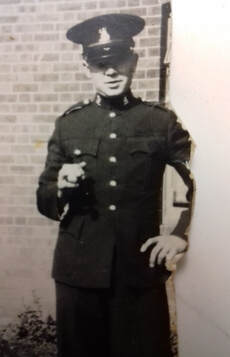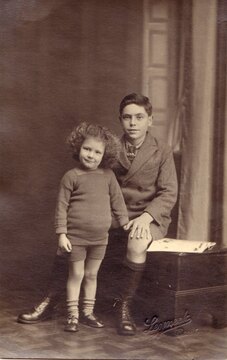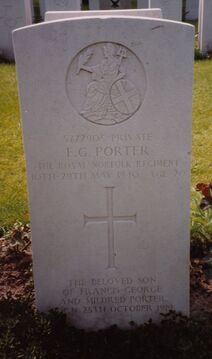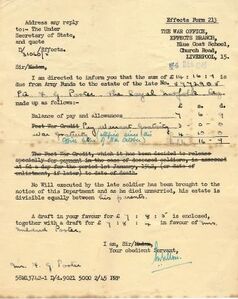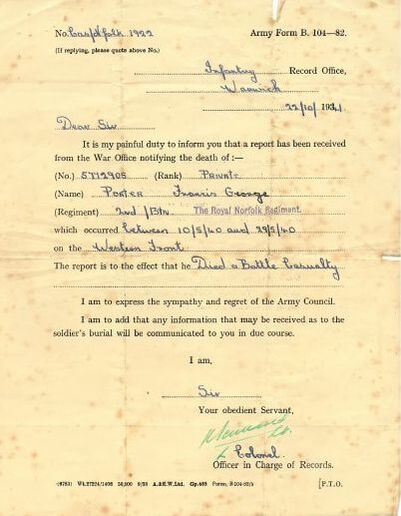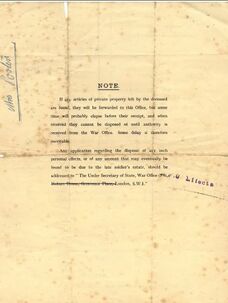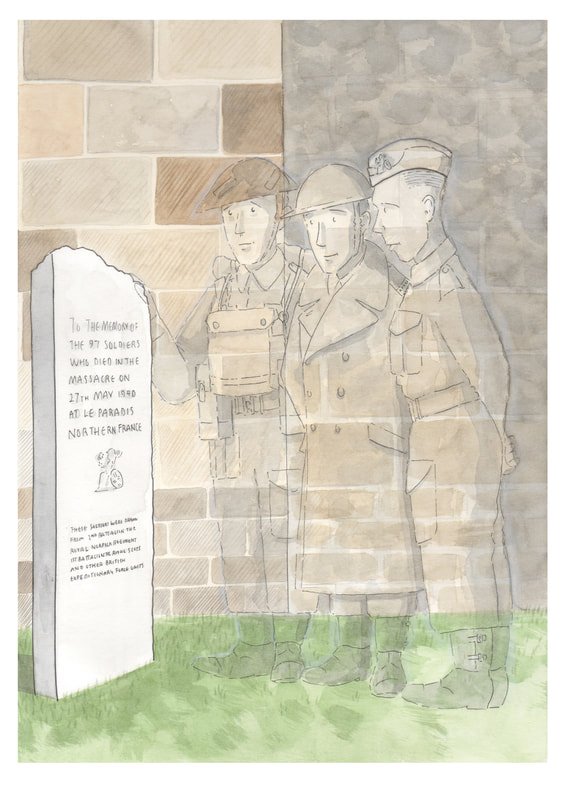Private Francis George Porter
Private 5772905 Francis George Porter
2nd Battalion Royal Norfolk Regiment
Died 27th May, 1940
Aged 20
The following information was sent to us by Edmund and Julia Gibbs, who are Francis' first cousins once removed.
As part of the British Expeditionary Force, the Norfolks had fought fiercely against a better equipped German army in the retreat towards Dunkirk.
On 27th May, 1940, Francis and other members of a Pioneer platoon were at Battalion HQ at Duriez Farm in Le Paradis. The Platoon Sergeant Major came to them asking for volunteers to blow up a nearby bridge at Pont d'Avelette, to hamper the German advance.
Francis volunteered, along with three other Pioneers, led by Lance Corporal "Misler" Mason. These included "Strips" Farrow and a Private Reeve. The only available vehicle was the commanding officer's Humber, which they and the driver, a man named Hawker (this may have been Private Douglas Auker from King's Lynn in Norfolk), loaded with explosives and detonators before setting off.
As they approached the bridge they saw a house on their left from which a machine gun suddenly started firing, riddling the car with bullet holes; the Germans had in fact already crossed the bridge. Miraculously, no-one was hit. The driver brought the car to a halt, and they all piled out before the driver swung the car around in an attempt to evade the enemy fire. By the time the four Pioneers got to the canal the car was hit again, this time with an almighty explosion as the car blew up, along with the driver.
From the canal bank they were able to fire off their few rounds at the Germans in the house before discarding their rifle bolts and escaping down the canal, all means of blowing the bridge having now gone. They came to a point where they stopped, while their corporal went ahead to try and find a safe place to climb out. They were unarmed and up to their necks in deep water, both literally and figuratively.
Francis told Ernie Farrow, the man next to him, that he was going to have a peek over the top of the bank and at that instant a machine gun opened fire and Francis was killed. Ernie tried to hold him up but realised that it was no good as he was dead. Another man named Reeve was also killed moments later. Ernie Farrow was captured along with a wounded Corporal Mason, and they became prisoners of war.
Francis was buried in a local churchyard and his body was later exhumed and interred at the cemetery in Dunkirk. Edmund Gibbs writes: "He is my first cousin once removed – my father’s cousin – and as Francis is my middle name, it is my honour to be a living memorial to this brave young man."
Julia and Edmund's father, Douglas Gibbs, was the cousin of Francis Porter and was brought up by Francis' parents, George and Mildred Porter, regarding them as his own parents. Douglas was ten years younger than Francis and thought of him as his brother.
"Our father visited Le Paradis in the last few years, and the bridge, and also Francis' grave at Dunkirk, with our cousin Edward Gibbs. We believe that Douglas met Ernest "Strips" Farrow at some point," Julia told us.
Below are some of Francis' army records. Click on the images to enlarge them.
2nd Battalion Royal Norfolk Regiment
Died 27th May, 1940
Aged 20
The following information was sent to us by Edmund and Julia Gibbs, who are Francis' first cousins once removed.
As part of the British Expeditionary Force, the Norfolks had fought fiercely against a better equipped German army in the retreat towards Dunkirk.
On 27th May, 1940, Francis and other members of a Pioneer platoon were at Battalion HQ at Duriez Farm in Le Paradis. The Platoon Sergeant Major came to them asking for volunteers to blow up a nearby bridge at Pont d'Avelette, to hamper the German advance.
Francis volunteered, along with three other Pioneers, led by Lance Corporal "Misler" Mason. These included "Strips" Farrow and a Private Reeve. The only available vehicle was the commanding officer's Humber, which they and the driver, a man named Hawker (this may have been Private Douglas Auker from King's Lynn in Norfolk), loaded with explosives and detonators before setting off.
As they approached the bridge they saw a house on their left from which a machine gun suddenly started firing, riddling the car with bullet holes; the Germans had in fact already crossed the bridge. Miraculously, no-one was hit. The driver brought the car to a halt, and they all piled out before the driver swung the car around in an attempt to evade the enemy fire. By the time the four Pioneers got to the canal the car was hit again, this time with an almighty explosion as the car blew up, along with the driver.
From the canal bank they were able to fire off their few rounds at the Germans in the house before discarding their rifle bolts and escaping down the canal, all means of blowing the bridge having now gone. They came to a point where they stopped, while their corporal went ahead to try and find a safe place to climb out. They were unarmed and up to their necks in deep water, both literally and figuratively.
Francis told Ernie Farrow, the man next to him, that he was going to have a peek over the top of the bank and at that instant a machine gun opened fire and Francis was killed. Ernie tried to hold him up but realised that it was no good as he was dead. Another man named Reeve was also killed moments later. Ernie Farrow was captured along with a wounded Corporal Mason, and they became prisoners of war.
Francis was buried in a local churchyard and his body was later exhumed and interred at the cemetery in Dunkirk. Edmund Gibbs writes: "He is my first cousin once removed – my father’s cousin – and as Francis is my middle name, it is my honour to be a living memorial to this brave young man."
Julia and Edmund's father, Douglas Gibbs, was the cousin of Francis Porter and was brought up by Francis' parents, George and Mildred Porter, regarding them as his own parents. Douglas was ten years younger than Francis and thought of him as his brother.
"Our father visited Le Paradis in the last few years, and the bridge, and also Francis' grave at Dunkirk, with our cousin Edward Gibbs. We believe that Douglas met Ernest "Strips" Farrow at some point," Julia told us.
Below are some of Francis' army records. Click on the images to enlarge them.
To view our page on Private Ernest "Strips" Farrow click here.
Much of the information above is taken from the book "From Le Paradis to Kohima" by Peter Hart.
Much of the information above is taken from the book "From Le Paradis to Kohima" by Peter Hart.
A Special Piece of Artwork
THE following piece of artwork was commissioned by Julia Gibbs and is reproduced with the permission of Julia, the Gibbs family and war artist illustrator Timothy Godden whose skills brought the piece to life.
Julia Gibbs has written her own blog which is full of family details and photographs and we are delighted that she has given us permission to link to it. Just click here
Julia Gibbs has written her own blog which is full of family details and photographs and we are delighted that she has given us permission to link to it. Just click here
